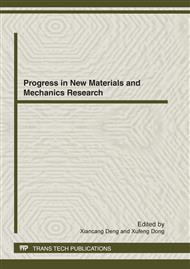[1]
Xu Peng, Development Study on a New-style Domestic Low-pollution-emission Gas Burner, Beijing university of civil engineering and architecture, (2001).
Google Scholar
[2]
Domestic gas instantaneous water heater, GB 6932-(2001).
Google Scholar
[3]
Analysis of natural gas by gas chromatography, GB 13610-2003-T.
Google Scholar
[4]
Fu ZhongCheng. Gas combustion device. China architecture & building press, (1984).
Google Scholar
[5]
TongJi University. Gas combustion and Application. China architecture & building press, (2000).
Google Scholar
[6]
Jin ZhiGang. Gas Test Technology Handbook. China architecture & building press, (2011).
Google Scholar
[7]
Tian ShengYuan. Experiment Design and Data Analysis. China architecture & building press, (1988).
Google Scholar
[8]
D.P. Mishra, Experimental studies of flame stability limits of CNG–air premixed flame, Energy Conversion and Management, Volume 48, Issue 4, April 2007, Pages 1208-1211.
DOI: 10.1016/j.enconman.2006.10.011
Google Scholar
[9]
Bernard Lewis, Guenther von Elbe, Combustion, Flame and Explosion of Gases, Academic Press; 3 edition (July 12, 1987).
Google Scholar
[10]
Pierre Pelce and Paul Clavin, Influence of hydrodynamics and diffusion upon the stability limits of laminar premixed flames, Journal of Fluid Mechanics (1982), 124: pp.219-237.
DOI: 10.1017/s002211208200247x
Google Scholar
[11]
Jared Crosby, Lean Premixed Flame Stability Investigations, UTSR Gas Industrial Turbine Fellowship Participant at Pratt & Whitney, May 23 - Aug 12, (2005).
Google Scholar
[12]
S Ishizuka, C K Law, An experimental study on extinction and stability of stretched premixed flames, 19th Symp Int on Combustion (1982) , Volume: 379, Issue: 1, Publisher: The Combustion Institute, Pittsburgh, Pages: 327-335.
DOI: 10.1016/s0082-0784(82)80204-x
Google Scholar
[13]
Paul Clavin, Dynamic behavior of premixed flame fronts in laminar and turbulent flows, Progress in Energy and Combustion Science, Volume 11, Issue 1, 1985, Pages 1-59.
DOI: 10.1016/0360-1285(85)90012-7
Google Scholar


